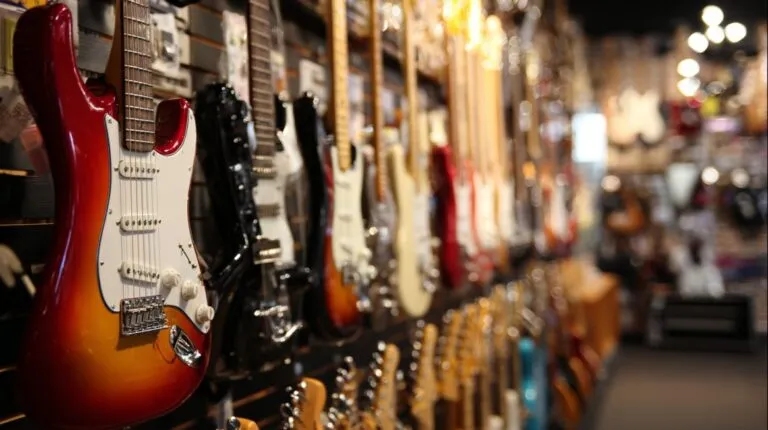Some of my favorite guitarists have different approaches to picking.
Pat Metheny relies heavily on legato, letting his fretting hand do most of the work, while John McLaughlin and Al Di Meola articulate almost every note with strict alternate picking.
Les Paul and Barney Kessel, on the other hand, are known for their sweep-picking.
I like to mix all these styles using economy picking—a blend of alternate, sweep picking, and legato.
It’s a versatile approach that combines the strengths of each technique.
In this Weekly Workout, we’ll cover the basics of alternate picking, sweep picking, and legato, and then bring them together to elevate your playing.
Table of Contents
Toggle1. Week One
First week, we’ll focus on some basic picking exercises that also work well as warmups. I recommend using a metronome, starting slow, and gradually increasing your speed. The first few examples are based on an open C chord, so hold down that shape and focus on your picking hand.
Alternate Picking
Examples 1a and 1b are designed to help you practice alternate picking—downstrokes (toward the floor) followed by upstrokes (toward the ceiling). As you play, keep your wrist relaxed and try to pick as close to the strings as possible, ensuring each note is picked evenly.
Sweep Picking
Picking consecutive notes on adjacent strings can be tricky with alternate picking. Here’s where sweep picking comes in.
Next, you’ll see how efficient it can be: play the C chord with a downstroke from strings 5 to 1, followed by an upstroke from strings 2 to 4. After picking each note, rest your pick on the adjacent string to be ready for the next note—this helps build speed!
Legato Techniques
Now, let’s shift focus to your fretting fingers with some legato techniques. You’ll practice chromatic hammer-ons, while Example 4b adds pull-offs.
Use downstrokes for each picked note, and aim to make the slurred notes as even and smooth as the picked ones. For more of a challenge, try these exercises across different strings and positions on the neck.
2. Week Two
In the second week, we’ll focus on applying economy picking to the G Mixolydian mode (G A B C D E F) in one octave. Start with alternate picking. To challenge yourself further, try reversing the pick strokes by starting on an upstroke.
Legato and Alternate-Picking
Next, incorporate legato techniques into your picking by using mostly downstrokes, combined with hammer-ons and pull-offs. This will help build fluidity between picking and fretting hand coordination.
Sweep Picking
Now, move on to sweep picking across two adjacent strings. To make sweep picking smoother, angle your pick slightly as you move across the strings—this will help the pick glide easier and make the sweeps more efficient.
Economy Picking
End the week by practicing, which focuses on economy picking. Work on these figures until they feel natural and effortless. Once comfortable, feel free to transpose the pattern to other scales or modes to expand your versatility.
3. Week Three
Third week, we’ll explore picking techniques using the A minor pentatonic scale (A C D E G). This scale is common in blues and rock, and it works great for economy picking. Start by playing the scale in the fifth position with strict alternate picking.
Legato and Alternate-Picking
Once you’re comfortable with the scale, incorporate hammer-ons and pull-offs, focusing on downstrokes. The two-notes-per-string layout of the pentatonic scale makes it natural to add these slurs for smoother transitions.
Sweep Picking
For sweep picking, shift between the second and fifth positions. This movement makes it easier to apply sweeps while playing the scale.
Economy Picking in Four-Note Groups
Now you’ll practice economy picking in four-note groups. Pay attention to where you sweep between adjacent strings—like between strings 4 and 3 on beat 1, and strings 3 and 2 on the “and” of 1.
Use hammer-ons and pull-offs where you can, such as on beats 2 and 4 of bar 1. For a challenge, try transposing these exercises higher up the neck—move each note up three frets to play the C minor pentatonic scale (C–Eb–F–G–Bb).
4. Week Four
Last week, we’ll move beyond scales and apply economy picking to a jazzy I–VI–ii–V progression (Fmaj7–D7b9–Gm9–C7b9) in the key of F major. This line includes plenty of arpeggios and chromatic notes to challenge your picking technique. Start by playing the lick with alternate picking. Work through it slowly until it feels natural.
Sweep Picking
Because of the arpeggios, such as the Fmaj7 in the first measure, sweep picking can make this line more efficient to play. Try focusing on smooth transitions between strings.
Legato Techniques
By adjusting some of the fingerings, you can add hammer-ons and pull-offs to reduce the workload on your picking hand. This approach helps keep the line fluid and minimizes the number of pick strokes needed.
Economy Picking
For maximum efficiency, it combines alternate picking, sweep picking, and legato techniques in one economy picking exercise. This will help you blend all the techniques you’ve worked on in previous weeks.
















